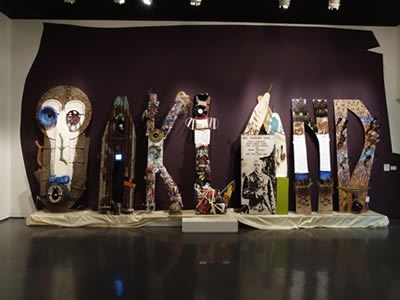
A Shrine To The Anti-Gentrification Gods of Oakland, May They Protect Us From the Invaders (2006), Black Dot Collective, mixed-media
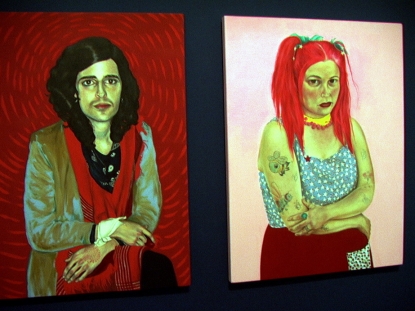
Devendra Banhart (2004), Jaina Apollonia Davis (2005), Christine Shields, installation view,Bay Area Now 4 (2005), Photo courtesy the author
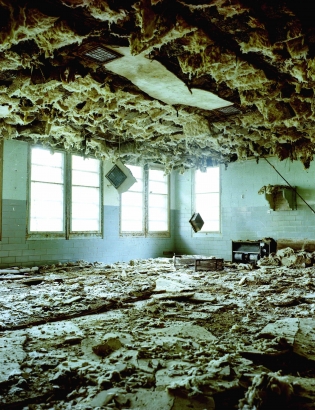
Cotton House (2005), Suzy Poling, Chromogenic Print, Oakland: East Side Story, Photo courtesy 2g Gallery, Chicago
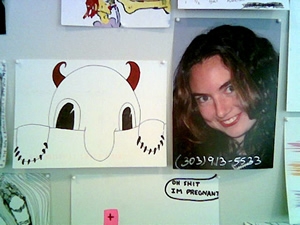
Untitled Installation detail (2006), various artists, Oakland: East Side Story, YBCA printed blank postcards and gave them to Oakland residents: "Everyone is invited to make a piece of mail art and mail it to YBCA to have their postcards displayed in the exhibition." Photo courtesy the author
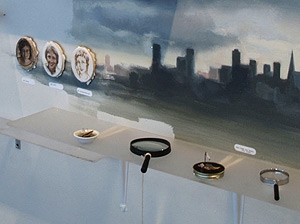
The Tragedy of Counting, or How Long Does it Take for a Friend to Become a Constituent, detail (2006), Gabrielle Wolodarski, Mixed media installation, Oakland: East Side Story, Wolodarski, an associate of the Rock Paper Scissors Collective, included in her installation portraits of many of the collective's members. Photo courtesy YBCA
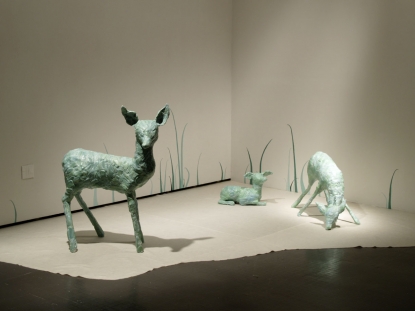
Deerodorant (2005), Lucrecia Troncoso, Irish Spring Original soap, felt, and paint, Sampling Oakland, Photo courtesy the artist
Feature: Essays
Sampling What?
Editors’ note - Six years ago, when we began brainstorming on ideas for an art publication, one of our foremost goals was to provide a forum for regional voices and points of view. With so much compelling work happening in the Bay Area, our thinking went, surely there was a need for more and better critical dialogue than the Bay Area press was providing. Even today, Stretcher’s tag line “Visual Culture in the San Francisco Bay Area and Beyond” remains a core part of our vocabulary and reflects a regional orientation. But in an increasingly interconnected, globalized, world, how useful is a regional approach to looking at art? What do we gain from this point of view and what do we lose? Using the two recent Oakland shows at Yerba Buena Center for the Arts, Sampling Oakland and Oakland: East Side Story as a reference point, artist/cultural critic Gordon Winiemko raises these and other key questions. We hope these questions will resonate as we explore the relationship between global and local thru a series of new articles beginning in 2007. What do you think of regionalism, survey shows and place-centric art scenes? This essay generated lively discussion within our group but we’d love to hear what you think. Click on the comments link at the bottom right corner at the end of this article and add your voice to the dialogue.
Not long ago at a gallery opening in Los Angeles, I had the following exchange with a fellow artist:
ME – I’m from Detroit originally, but I lived in San Francisco for a long time.ARTIST – Yeah, San Francisco… it’s nice up there, but what have they got going on up there? I mean, Tom Marioni and conceptualism and all that, that’s cool, but what’s been going on up there lately?
I realized that this instance of an Angeleno looking down his nose at SF is exactly why many San Franciscans and people in the Bay Area at large look down their noses at LA. What else would one expect from one of the premier cities in the United States, especially one known for its bohemianism, than that there would be a great number of individuals making all kinds of art there? Some work you would respond to, the rest not so much. To expect it to coalesce into recognizable movements or styles or scenes seems more in line with marketing than art.
Yet as crass or superficial as it might sometimes come off, maybe it’s a human need, or tendency, to identify patterns, categorize, try to get a handle on things. The preponderance of art survey shows would seem to bear this out. We’ve just had yet another year of the Whitney Biennial, the show that still makes an American artist’s career. Still, I’m hard pressed to think of one positive review of this year’s edition, either formally or informally. How could it be any other way? To hold up a collection and say, “this is representative” is to go head to head with each and every spectator’s notion of the same.
With a regional survey, there’s the added difficulty in that what is being represented is not some concept or category, but a place, with all the history and associations that implies. That’s not so acutely problematic in the case of exhibitions that cover as large a chunk of geography as, say, Baja to Vancouver (which toured in 2004) or even the Orange County Museum of Art’s California Biennial (the current edition of which is up until the end of the year), as where the focus is as singular as a place like Oakland, California, and I’m distinctly left with that feeling after taking in first Sampling Oakland and then its companion show, Oakland: East Side Story, at Yerba Buena Center for the Arts. It would seem that the success of these two Oakland shows is predicated on the degree either to which they uphold a visitor’s conception of the “Oakland arts scene,” or on how much a visitor is prepared to suspend their disbelief and accept that, here, in the YBCA galleries in San Francisco, here is Oakland…
I suppose it could be said that I am being just like that condescending Angeleno. Why don’t I forget about Oakland, and just take in the art? But condescension is something that seems to hang over this very enterprise. Showcased by a venerable San Francisco institution, it comes across rather as “oh, let’s see what those people are doing over there in that nice little town.” It’s not as though YBCA has ever thought it necessary to mount Sampling San Francisco. Still, one might be justified in saying that Beautiful Losers (a YBCA co-production with the Cincinnati Contemporary Arts Center) was precisely that show, in everything but name, given its emphasis on San Francisco’s own “Mission School.” And yet, while the shadow of regionalism was undeniably present, the thematic focus was varied and nuanced to the degree that San Francisco was simply implied, rather than overtly stated. Bay Area Now is the more apt comparison, but that’s precisely the point – aren’t Oakland artists already encompassed by a showcase of the Bay Area?
The word that I find myself reaching for is provincialism. It’s always struck me as funny, how people in New York vehemently insist on distinguishing Brooklyn from Manhattan, as though they are two entirely different places, and not part of the same city. “Oh, Queens is so far…” I suppose it’s inevitable, people always try to make their world smaller. I do know, from the point of view of living in San Francisco, that the East Bay can seem far away. At least one person told me she was glad to have work she otherwise would have trouble seeing brought from over there to over here. But if distance is really the problem, maybe directing the kind of energy that was put into this show towards agitating for an expanded BART schedule might be a good idea.
Still, this begs the question, why isn’t that work habitually brought “over here”? Actually, I thought it already was. I’m accustomed to seeing work by many of these Oakland artists on both sides of the Bay. Then again, there is a feeling in the Bay Area that the local art scene is under-represented and under-rated – not just outside the Bay Area, but also locally. Indeed, this is evidently part of YBCA’s mission, to “emphasize younger and emerging artists” and to “nurture a special bond with the San Francisco Bay Area Arts Community,” as it says on their website. When I pick up a condescending vibe from these Oakland shows, it’s possible that I forget just how elitist the art world can be. Still, I have to question whether the appropriate solution to highlighting regional art is to mount shows that say, emphatically, “look at the region!” Might it not be better to concentrate on building shows around engaging, compelling themes, with local work that highlights those themes, than to court all the problems of a regional survey? How does it help, from the standpoint of wanting the Bay Area to be more of a player in the art world, to divide the Area up into little domains, and imply that one of those domains needs a helping hand?
The same might be said of Bay Area Now. On one hand, how could it not resonate, the desire to know “what’s happening here” – and happening now, for that matter. Human beings seem uniquely coded to respond to words like “now” and, maybe even more so, “new,” such that you find those words plastered on countless consumer products. Then again, wanting to be on top of the latest trends, needing to know what and who is hot – this seems redolent of what the last BAN struck me as showcasing, scenesterism, yet another manifestation of erecting and enforcing boundaries, of us-and-them’ing. While there was a lot of diverse work in the ‘05 BAN, that sense of “look at us, we’re special,” really hung over the show, whether in Christine Shields’s portraits on canvas of SF music scenesters, or Johnny Hatori’s video portraits of the scenesters orbiting Adobe Books, or even in Stretcher’s own collection of interviews set up on a monitor in the lobby. “Adobe is the center of the universe,” one talking head said, in the Stretcher video. Granted, there was more to the piece than that, but it seems perfectly natural and inevitable for such blatant boosterism to be there, as part of a show called Bay Area Now, and one with such a focus on “the scene.” The latter is something I’m still trying to understand, my initial sense of it as smug and smarmy I’m still trying to get beyond. On the one hand, it doesn’t seem like a purely Bay Area thing; an international analogue that comes to mind is the increasingly high profile Canadian group the Royal Art Lodge, whose body of work is a series of in-jokey drawings and other projects. Still, this kind of cliquish behavior does seem endemic to the Bay Area, and San Francisco in particular, maybe because of its size. Walking through the streets of the Mission, bumping into the same people all the time, it does sometimes feel like traversing the hallways of a high school. At the same time, this kind of being on the inside or being in the know is precisely what is both seductive and repellent about the elitist exercise of art, in general.
What might be more uniquely Bay Area is that boosterism. How do I know Bay Area artists want to be taken more seriously by the art world? Well, for one thing, they kept talking about it in the Stretcher video! I wonder if it was pride, whether born of perceived adversity or not, that motivated the Oakland shows’ guest curators, all of them fixtures of the Oakland arts, er, scene. And while a little bit of that celebration of the scene does pop up in these shows, I’m not left with a smarmy feeling; the curators’ earnest desire to present a collection of just damn good work shines through. But how can the best of intentions throw off the weight of regional survey baggage, those subjective notions of “what’s happening” and what “here” is? Oakland – what’s that, anyway? Gertrude Stein’s famous epithet “there is no there there” is still accurate; boundaries are conceptual, and everybody’s conception is inevitably different. And, for that matter, what’s an Oakland artist? A few times, looking at the work in these Oakland shows, I had a moment of surprise, thinking, “Oh, so-and-so’s an Oakland artist? I thought they lived in San Francisco!” In a year when the Whitney proclaimed loudly, we live in a global community, what difference can the span of a bridge make? Can the work of the artists who I thought lived in SF be any different for having been made in Oakland? Maybe, but most likely only in that there is more of the work, or any work at all, than if the artists had continued living in the inflated San Francisco rental market.
What makes it even more ironic is that I was a participant in Sampling Oakland, albeit marginally, having been curated into one of the performance nights nominally associated with the show. That’s part of the point. I don’t even think of myself as belonging to Sampling Oakland, let alone Oakland itself, let alone anywhere, really. I was asked to perform at YBCA, and I did. What If I were to say that I don’t live in Oakland at all, would that reveal my contribution to be ersatz somehow? What if I used to live in Oakland, but don’t any more? That this is actually true of some of the artists in these shows strikes me as an indicator of the shaky ground of the “regional” perspective. I’ve spent a long time in San Francisco, that I can guarantee – does that make my art San Francisco art? I had been thinking it was Gordon Winiemko art.
Then again, maybe the very point of view I am evincing here is eminently of San Francisco, or the Bay Area. I don’t understand why anyone would align themselves with a narrow boundary, or category. It seems so limiting. But you know, I am a person who has never had school spirit. For many other people, limits are comforting. And people like to see themselves – or the groups they conceive of belonging to – reflected, either through similarity or difference. I suppose that is why regional survey shows flourish.
Is it just me, that I came away from these Oakland shows with a checklist of art trends, to the near exclusion of the unique facets of the work? But isn’t “trend” just a word for “what’s happening,” that which a survey purports to showcase? I’m not sure if the “regional” frame encourages that kind of curatorial focus, or that kind of spectator perception, or both. Over the course of both Sampling Oakland and Oakland: East Side Story, I saw: service-as-art, “Mission School” inflections, portraiture, hyper-detailed drawings, murals, more portraiture, faux nature in the form of deer sculptures (a cousin to the fake woodgrain phenomenon), still more portraiture, interactive technology and that celebration of the scene. The thing is, even if I’d want to hold up these trends for my LA friend as examples of “what’s happening” in Oakland, I saw most, if not all, this kind of work at the 2005 Bay Area Now, and even then a lot of it is not particularly unique to the Bay Area.
What does distinguish the Oakland shows is the number of pieces showcasing the Oakland landscape, in a variety of ways. Gertrude’s characteristically oblique jibe aside, there are some aspects of “there” we all can recognize, especially when they are spelled right out for us, as in the Black Dot Collective’s wall-length, man-height row of letters spelling out OAKLAND, like a Norcal Hollywood sign (A Shrine To The Anti-Gentrification Gods of Oakland, May They Protect Us From The Invaders, 2006, exhibited in Sampling Oakland). Another touchstone is Vancouver artist Ron Terada’s faithful replica of a highway sign marked with the words “Entering the City of Vancouver” (included in Baja to Vancouver, incidentally). The notable difference is that, in Terada’s piece, what is in play are notions of the simulacrum and of signification itself, while the Black Dot Collective piece comes across as yet more of that boosterism. Still, when you consider that Oakland is a place with a large population of African Americans, and that the mission of the Collective is precisely to raise visibility of this historically disenfranchised group, then boosterism starts to look more like activism, such that any complexity that might be lacking seems beyond reproach.
In other work, like Ben Riesman’s video installation documenting the artist’s relentless, hypnotic, point-of-view traversing of space, or in Sue Costabile’s video-cum-slide-show, 99 Famous Views on Garage Doors (these two pieces housed in an arresting, atmospheric sort-of-cellar that Kevin Slagle made out of old wood taken from Oakland houses), or Tia Factor’s playful, perspective-shifting paintings of extruded landscapes, one can recognize facets of an environment that are incidental to the degree that the most appropriate observation is simply “hey, there’s Oakland!” And where the city does not announce itself so overtly, one need only resort to the promotional literature to find it, as in Scott Hove’s sculptures made out of rope recycled from Oakland ports, or Suzy Poling’s photographs of “abandoned, decrepit interiors,” as the YBCA press release calls them. It goes on to say that said interiors are “reminiscent of the many unoccupied buildings that lie in disrepair in downtown Oakland.” Reminiscent? Does that mean the images are not actually of those buildings, not of Oakland at all? In any case, this looks like one of those cases of trying to shoehorn an artist’s work to fit a pre-conceived notion of the titular subject matter. Poor Oakland, city of disrepair. I wonder if native Oaklanders would feel the same way about this kind of work that I did about the Made in Detroit series of photographs by Canadian artist Stan Douglas, that struck me as simply recapitulating the same tired old story of white flight/urban blight.
What would have been refreshing and provocative to have seen in these Oakland shows is work that investigates what it means to try to capture a sense of place. The Terada “Entering Vancouver” piece comes to mind again. By representing his home with a literal sign, and an institutional one at that, the Vancouver artist coaxes us to consider what it means to signify, what it means to represent. I found such questions sorely absent from Sampling Oakland and Oakland: East Side Story, whether because so-called “Oakland artists” are not asking them, or because the curators did not include such work. Maybe the boosterism that is one of the motivating forces behind this exercise precludes that kind of potentially destabilizing self-examination. In any case, what I was left with is what I chided my LA friend for overlooking, a diverse collection of art, some of which will resonate, the rest not so much. Isn’t that already on display in any show in San Francisco, Oakland, or the Bay Area in general?
(4) COMMENTS
Basically, you could have the most highly anticipated, highly rated and highly consumed exhibition about Oakland (or SF for that matter) and you would hardly even begin to scratch the surface of an all-inclusive representation of the variety of artists, curators, writers, etc that call one particular city home. However, Oakland has seen a mad growth in artist-run galleries and other grass-roots cultural spaces in the last five years and that begs furter investigation from all angles, but this by no means says anything to the history of previous galleries in Oakland, past curators developing projects in Oakland (anyone remember the past amasing exhibitions that one could view at the Oakland Art Museum, for instance?) or artists living in Oakland and showing their work both in Oakland AND San Francisco…maybe even more so in SF! Eighty percent of the faculty I studied with in two different academies in Oakland LIVED in the East Bay and exhibit REGULARLY in SF. I don’t think Strecher has the bandwidth for me to list them all! ![]() That said, a survey exhbition is simply a survey - it is about touching the surface lightly and watching ripples cascade to far reaching waters. Maybe, just maybe, Oakland has amassed such a significant group of artists and art enthusiats that SF simply cannot call itself the center of Bay Area Art. And maybe that is why Sampling Oakland was enacted, to co-opt the strength of Oakland’s art scene before it takes over. Or, maybe the curators of Sampling Oakland recognize the need to open up Yerba Beuna to a Bay Area Centric Viewpoint other a SF local viewpoint. Either way, the showcasing of Oakland-based artists gives excellent opportunities for the included artists to HAVE BETTER CAREERS. Isn’t that also something to reward YBCA for? The art world, local or international, is just like any other energy consuming, cultural determining machine - but it is the individual who has the choice to either hack it or submit to it.
That said, a survey exhbition is simply a survey - it is about touching the surface lightly and watching ripples cascade to far reaching waters. Maybe, just maybe, Oakland has amassed such a significant group of artists and art enthusiats that SF simply cannot call itself the center of Bay Area Art. And maybe that is why Sampling Oakland was enacted, to co-opt the strength of Oakland’s art scene before it takes over. Or, maybe the curators of Sampling Oakland recognize the need to open up Yerba Beuna to a Bay Area Centric Viewpoint other a SF local viewpoint. Either way, the showcasing of Oakland-based artists gives excellent opportunities for the included artists to HAVE BETTER CAREERS. Isn’t that also something to reward YBCA for? The art world, local or international, is just like any other energy consuming, cultural determining machine - but it is the individual who has the choice to either hack it or submit to it.
steven,
you make plain something i chose not to delve into, which is that one of the driving forces behind such an exhibition is the marketplace. it helps artists’ careers and i don’t doubt it helps YBCA to sell tickets. the marketplace is all about packaging, staying within accepted boundaries.
—which is to say passively resting on that packaging, on those boundaries, without examing them.
case in point. you say:
“Oakland has amassed such a significant group of artists and art enthusiats that SF simply cannot call itself the center of Bay Area Art.”
—“Oakland” is a person, with agency? once again, why does it matter where an artist goes to sleep at night?
i suppose if you *identify* with this concept of “oakland” then you want “oakland” to “succeed.” looked at from this angle, though, it seems you are doing what so many people do—hitch their cart to something bigger so they can self-promote without looking greedy or self-absorbed, and when they fail they can take refuge in the fact that it is that larger thing that is failing, and not they themselves.
your comment actually perfectly illustrates what i did call attention to—boosterism. you essentially say that the show is to boost the visibility of “oakland” and so-called “oakland artists,” which actually is just another way of saying “packaging and selling a product.”
Gordon,
Boosterism is a very interesting term, a very appropriate term, and somehow I feel it is a secret word, an embarrassing word, which has been used hesitantly within the art world. But isnít every curated exhibition a type of Boosterism? I think what is important to distinguish however is whether one is packaging their own selves or being packaged by others - and maybe
I would like to add to your application of Boosterism the personal benefit: artists, curators and artist-curator-friends of artists and exhibition space directors, use Boosterism for self-advancement either through self-promotion or kick-backs through the promotion of the other. Everyone wants to succeed, and because the art scene is a complicated, difficult and tightly knit clic (no matter what city you want to talk about…), success is limited by their network, their associations and, of course, their talent and ideas, but that is another story…
Now, I wouldn’t say it always does so, but I do believe experience over time will lead to changes in perspective. So, living in Oakland (or any city) can either change you willingly or unwillingly through the experience of living it…and when it does, the individual becomes part of the new identity by defaultóthere is no “time-based rule” as to when this happens, it just does, eventually. And, furthermore, this feeling of identity or knowledge of place never leaves…even if you move away. It is like a mental tattoo on the inner-skin of the brain, or a physical branding of the lining of the heart. So, when an individualóan artistóstarts seeing themselves as part of a place, like Oakland, they do feel the need for the place to succeed just as much as they want themselves to succeed. Artists should be active in progressing in their own self-initiated scene, all the time. Never wait. Does that mean that the Black Dot Collective was the most poignant group in the Sampling Oakland shows?
Yet, isnít it actually ìsmarterî if an artist can, through the available network, get someone else to step in and further their own self-initiated promotion? Doesnít that eventually leave more time for the art making process? And in this case, it would be the new Oakland galleries, and on top of that, YBCA. Wouldnít any participating artist in the YBCA show desire a dealer, someone to push and promote their work, and arenít exhibition places like Yerba Buena not the new dealers/negotiators of what the support network (read: financiers) should be paying attention to?
Let’s face it, the marketplace is important to every artistóan artist must locate it, use it, succeed in it, if they are to be a full-time working artist. Sure, some artists ignorant of the marketplace still succeed in making a living, but that is rare, no?

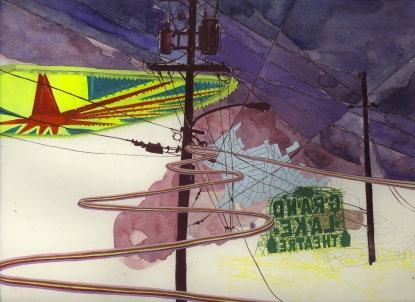
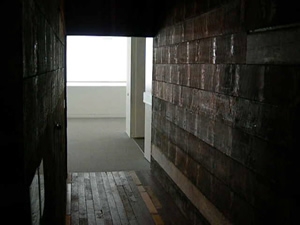
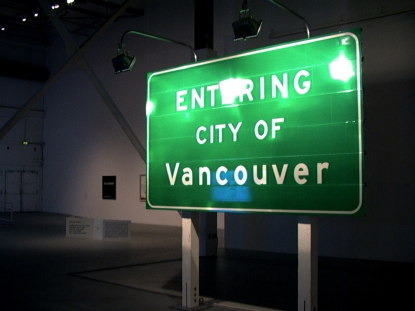
As a long time witness to art and artists in the SF bay area, I’ve seen countless times that “emerging artist” rise and subsequent mid-career fall of the non-trustfund artists who choose to stay in SF (and the inevitable, accompanying disillusion as shows and interest in their work dries up after roughly five years); the laudable but, in my opinion, misguided attempt by local curators and venues to market identifiable trends of production as “SF art” in an effort to capture a wider geographic audience for the bay area brand, and artists annointed to represent it- and the subsequent failure of that strategy; and the all too few curators, artists and art writers who do make it out to success in the wider art world, usually by relocating somewhere with a more vibrant economic basis for their survival (jobs in their field, collector bases), and- most importantly- never, ever continuing to identify themselves with the SF bay area brand. What seems odd to me is that the visual art community there mindlessly asks the same tired question year after year- “why doesn’t anyone else recognize how great we are?” I suggest posing a different question might help.
Ella Delaney • December 29, 2006